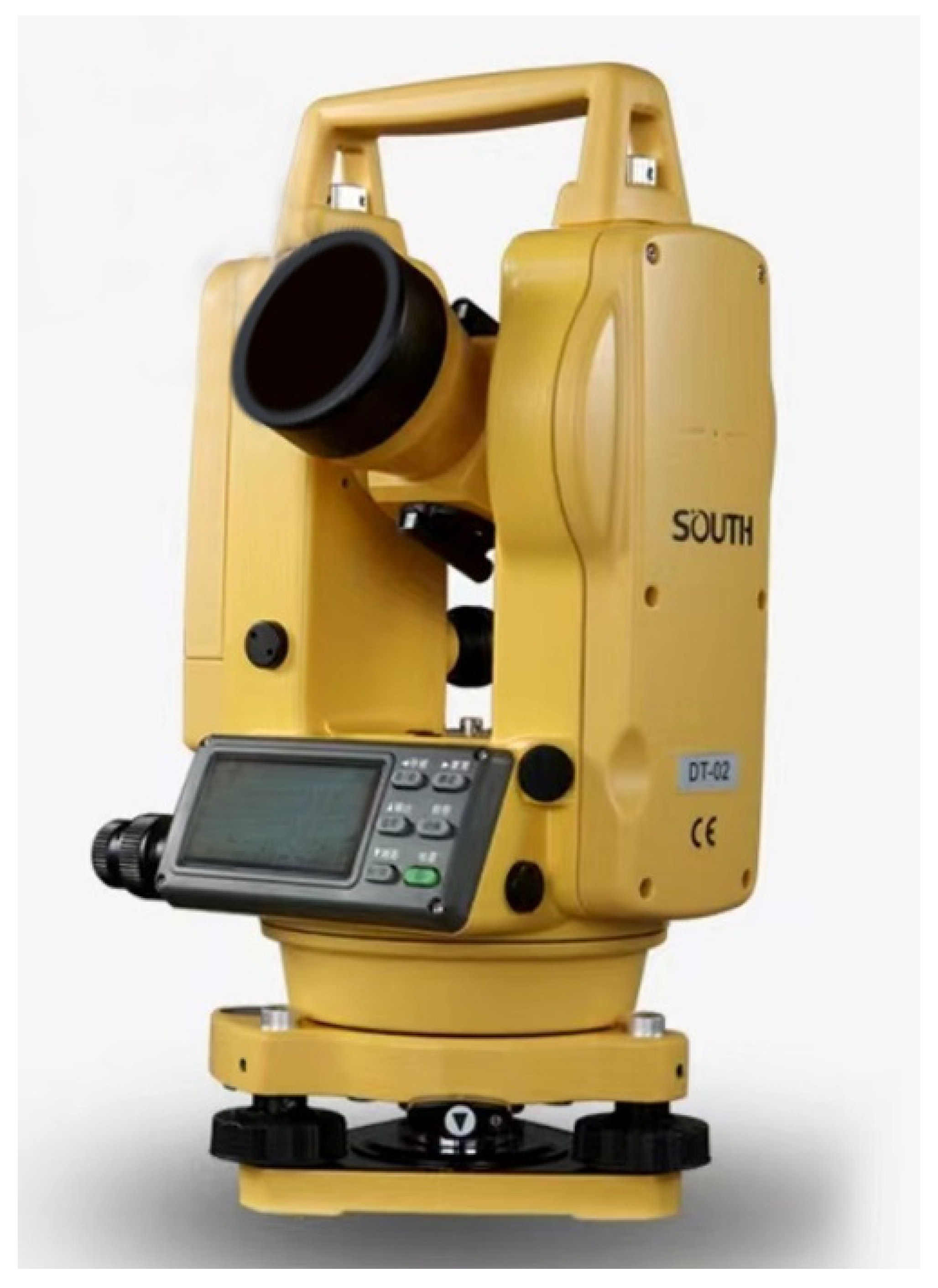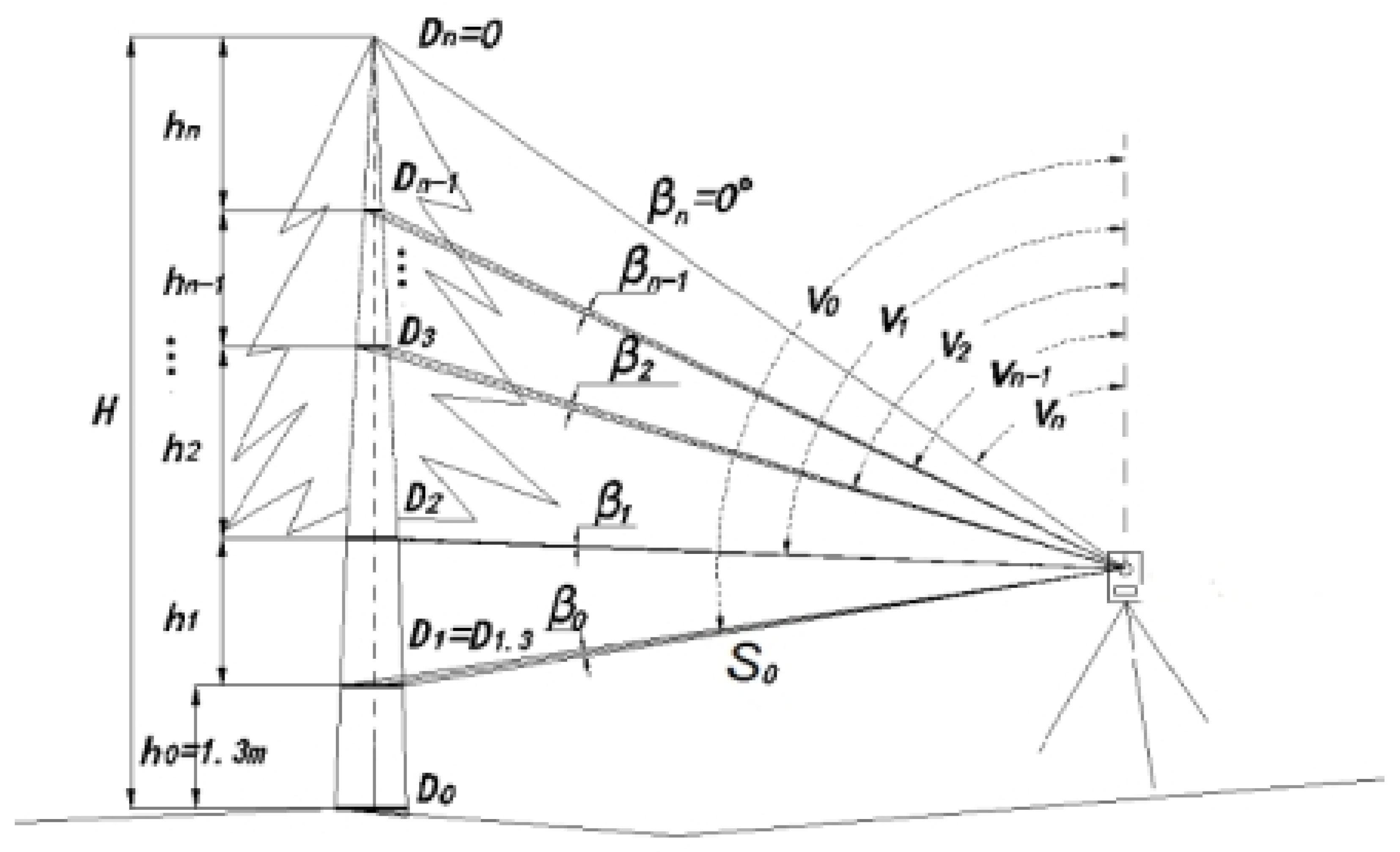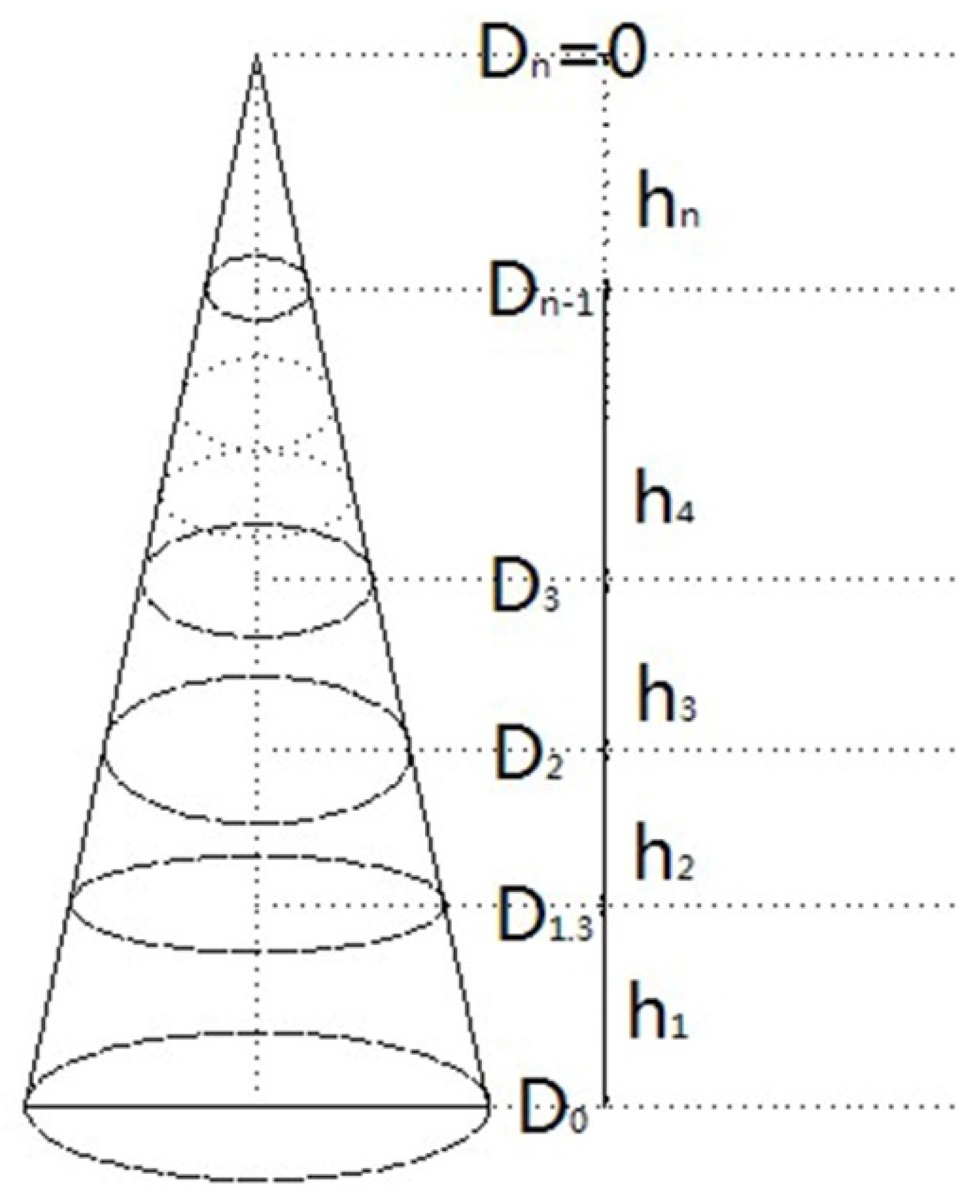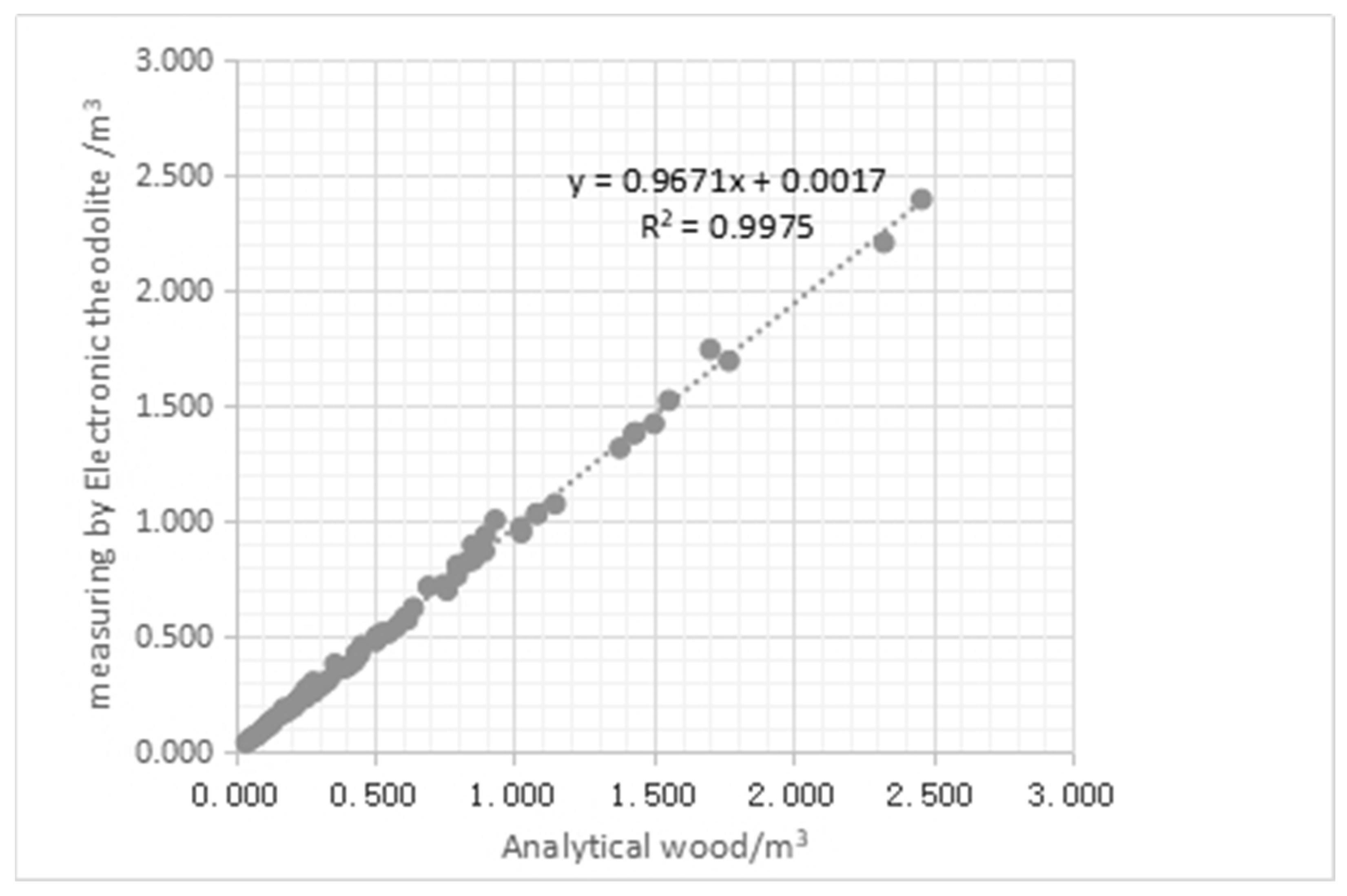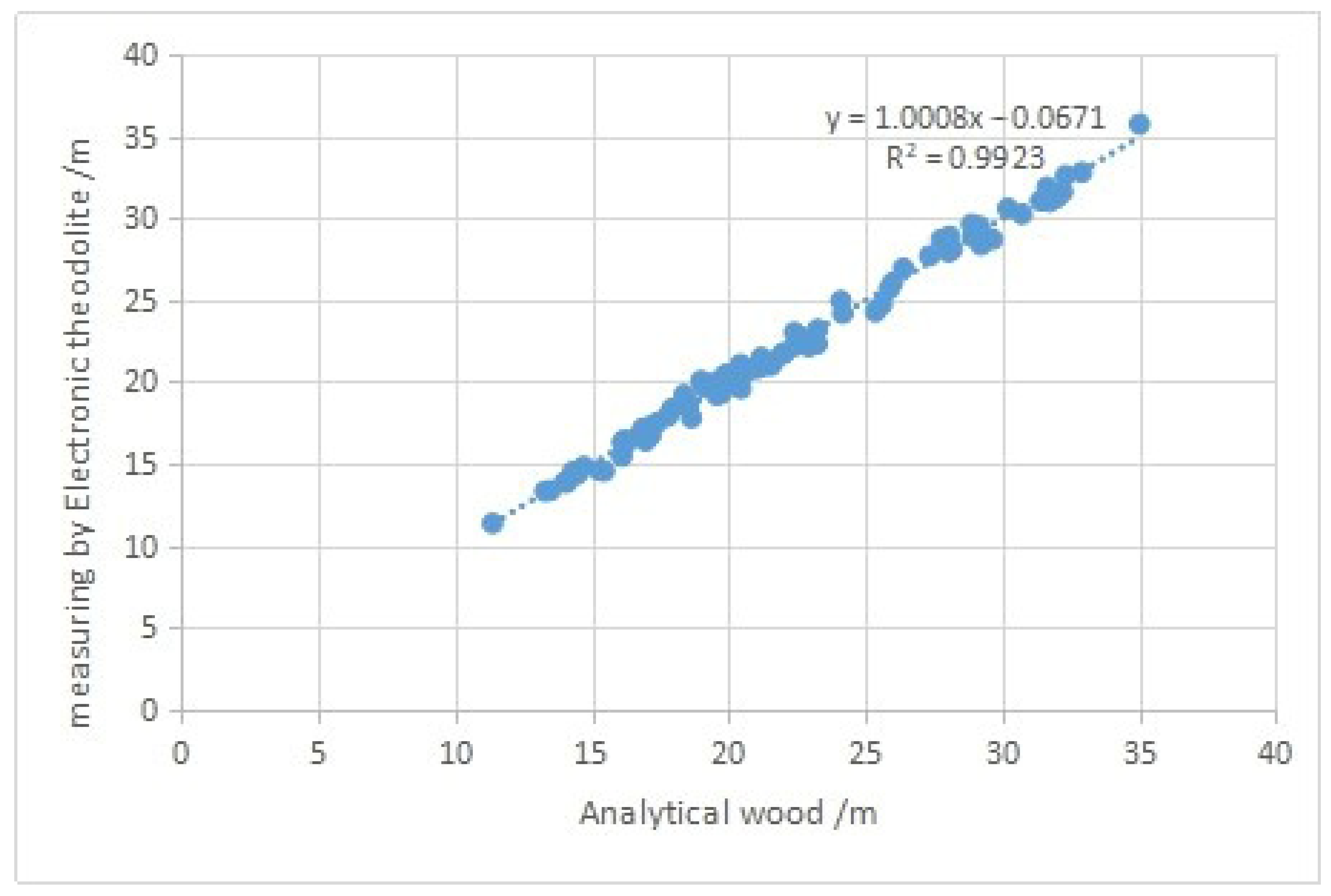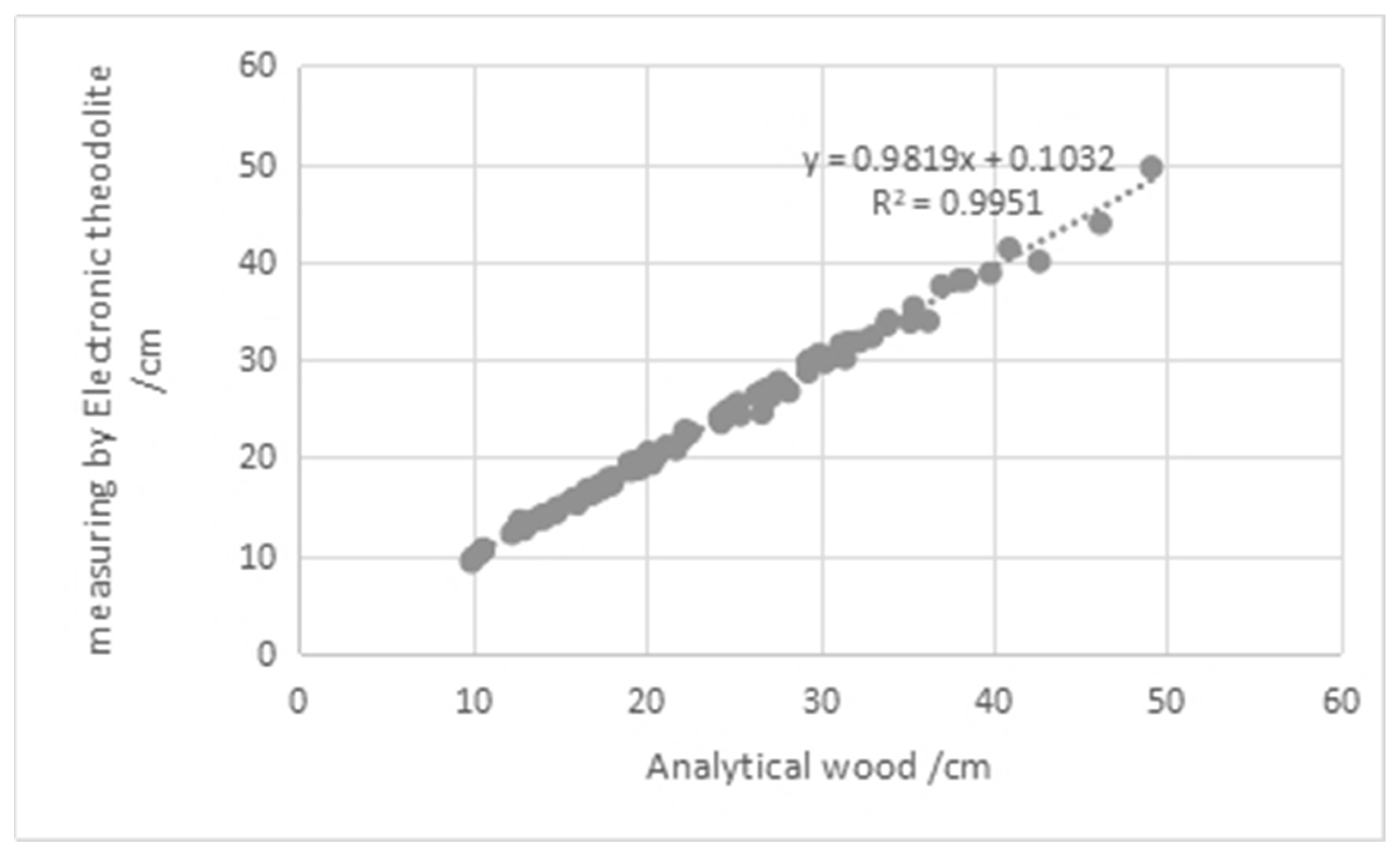1. Introduction
Diameter tree height and stem volume are the most significant factors in forestry investigations. Improving the measurement accuracy of these three factors is an important topic in forest tree measurement. In 1855, Pressler proposed the Wang Gao method [
1], Schliffel [
2] proposed the chest height rate method, and Jonson [
3] proposed the absolute shape rate method. On this basis, Xu Yuxiang of the Henan Forestry Institute proposed the point method in 1990. His analysis used 49 strains of 13 species of eucalyptus to compare the accuracy of the four methods [
4]. Since the beginning of the 21st century, with the development of modern forestry techniques, forest measurement technology has received increasing attention. Zaman et al. [
5,
6,
7,
8,
9,
10] used a 3D laser scanner to measure standing volume and compared the precision with that of traditional measurements. Feng Zhongke et al. [
11,
12] introduced digital close-range photogrammetry and total station measurement technology into the field of forest surveying. Y. Liyan presented a nondestructive method using CCD to measure tree height and volume [
13]. Xu Wenbing et al. [
14] used a compass, a total station, and a hand-held device in a forest resource survey. Comparisons of the precision provided by the different methods indicated that traditional compass measurements are insufficient to meet the developing needs of the forestry disciplines, and thus modern measurement technology will play an increasingly important role. Song Yuhui [
15] improved the method of calculating the stem volume by measuring the height of the tree with an electronic theodolite. The method finds the location of the point of view and applies the improved Wang Gao method to calculate the stem volume. Guo Baosheng et al. [
16] measured the stem volume using a total station. Zhao Fang et al. [
17] studied the method of measuring the volume under the canopy with a total station.
In addition, the common tree height measurement method measures the tree height by the triangle elevation standing height measurement principle [
18] and an electronic tree gun [
19]. The tree height can also be measured by photogrammetry techniques to obtain stereo image pairs, the tree height is then obtained through three-dimensional coordinates [
20,
21,
22]; LIDAR data for single tree height measurement [
23,
24]; single-chip cameras via the tilt angle; measurements of displacement [
25]; and many other methods. Among these, regarding the problem of canopy occlusion, Wang Xuefeng et al. [
26] proposed dividing the standing tree height into the height of the branches and the height of the canopy and then using the stereoscopic reconstruction technique to obtain the tree height. Zhao Fang et al. [
17] proposed a method for measuring tree height using a total station under canopy occlusion conditions. Brandtberg and Clark et al. [
27,
28] used small spot, high sampling density LIDAR data to estimate the understory tree height. St-Onge et al. [
29] used a combination of stereophotometry and LIDAR to measure the height of a single tree with an average sampling density of approximately 0.1 echo point per square meter. Suarez et al. [
30] used airborne LIDAR and aerial photography to estimate forest tree heights.
Other researchers have proposed error analysis methods for DBH, tree height, and volume measurements. Manuel et al. [
31] conducted research to evaluate whether height and upper-stem diameter actually improve the accuracy of volume estimation and its effect on prediction when measurement error is considered. Maria [
32] analyzed the standard error of tree height measurement, given the error caused by sight acuity of the operator at the creation of the line at the top of the tree. Ambrose et al. [
33] analyzed the uncertainty in individual tree measurements when these values were determined during inventory measurements. Steven [
34] analyzed the accuracy of DBH collected at a distance and performed a correlation analysis between light conditions and remote measurements. Because 3D laser scanners and total stations are expensive, bulky, and difficult to carry, the breast diameter ruler and electronic theodolite are still commonly used and were used in the actual tree measurement projects that were adopted for this paper. Although many studies have focused on improving the accuracy of diameter, tree height, and volume measurements as well as the assessment of measurement errors, there is at present no formal overall analysis concerning the accuracy of such measurements.
In this work, a mathematical model for calculating diameter, tree height, and volume error was derived to calculate the error in theoretical measurements. A dataset from a Beijing stand of Populus used trees classified into three sets, i.e., large, medium, and small. Moreover, a method utilizing F tests was proposed for analyzing the overall error based on the diameter, tree height, and volume factors.
3. Results
The theoretical values of the system errors in measuring the large-, medium-, and small-sized wood samples by theodolite are shown in
Table 2 and
Table 3. In the table, representative trees of the same tree species with large, medium, and small sizes are given. It can be noted from
Table 2 that when the electronic theodolite measures different sizes of wood, the error will vary slightly with the size of the tree. The system error of the measured tree height was 0.29–0.89%, while the system error of the measured diameter was 0.44–0.59%, and the system error of the measured volume was 0.31–0.99%.
Table 4 shows that on the large-scale sample wood, the relative error of diameter of
Populus cathayana Rehd was higher than that of
Populus tomentosa, and the relative tree height error of
Populus tomentosa was higher than those of the other two species. The relative error of the volume of
Populus canadensis Moench was higher than those of
Populus cathayana Rehd and
Populus tomentosa. In
Table 5, there is no medium-sized wood for the
Populus canadensis Moench. Therefore, compared with
Populus cathayana Rehd or
Populus tomentosa, for medium-sized wood, the relative error of diameter and tree height of
Populus tomentosa is higher than that of
Populus cathayana Rehd, and the volume error is 3.92%, slightly smaller than that of
Populus cathayana Rehd.
Table 6 shows that on the small-scale sample wood, the relative error of diameter and tree height of
Populus cathayana Rehd is higher than that of
Populus tomentosa, and the volume error of
Populus cathayana Rehd is slightly smaller than that of
Populus tomentosa. Data of all tested trees are listed in
Table 7. In this paper, the regression test was used to analyze the overall error.
The electronic latitude and longitude measuring data of the three tree species (groups) are used to calculate the linear regression equation, and the F statistic is calculated according to formula (1). The F test was used to measure the overall accuracy, which shows the difference between the measurement data from the electronic theodolite and the measurement data of the felled wood. As shown in
Table 8, all F values are smaller than the critical value at the 0.05 level, indicating that there was no significant difference between the electronic theodolite measurement data and the actual measurements.
Figure 5,
Figure 6 and
Figure 7 illustrate the comparisons between the tree height, diameter, and volume data of the measurement of the electronic theodolite and the actual measurements of the poplars. In
Figure 5, the F value is outside the rejection domain. We rejected the alternative hypothesis and accepted the null hypothesis, i.e., there was no significant difference between the two groups of volume data.
Table 9 shows that tree surveying by common precision electronic theodolite in China is more accurate than the requirement of error not exceeding the 3–5% standard.
4. Discussion
Comparing this study with earlier studies in China, there were some significant improvements. Cao et al. [
30] carried out research on measuring tree height and volume with theodolites. Five kinds of theodolites with different accuracies were applied to measure different species. The average relative error of tree height and volume was 1.20% and 4.27%, respectively, which is consistent with our result. However, it did not explain the experimental tree species, which would have a different effect on the error. For that, we provided a more detailed explanation of the influence of different tree species on the error. Du [
31] conducted an experiment on the height and volume of three tree species (
Platycladus orientalis,
larch, and
poplar) with an electronic theodolite in Beijing. He found that the average relative errors of tree height and volume were 1.71% and 1.58%, respectively, passing the verification of the F test. Even though the accuracy of the result was higher than ours, the analysis of tree diameter and its influence on tree volume was lacking in his study. Considering the tree diameter as an important factor for volume calculation, we analyzed the error of tree diameter and applied it in calculating the system error of tree volume. Zhang [
32] analyzed the system error of tree height and volume measurements in continuous forest inventories based on the law of error propagation. However, it was only deduced from the theoretical model and not verified by specific experimental data. In contrast, we took a total of 87 stand trees in Beijing as the experimental sample to verify the theoretical value of the system error of tree diameter, height, and volume. The trees were divided into three sample groups according to size. The study from Gao et al. [
33] focused on how to better measure the upper diameter by sections and then calculate the volume based on 198 larch trees using electronic theodolite. According to the finding that a tree divided into 10 sections can better simulate the trunk shape and calculate the volume, we divided all sample trees into 10 segments for observation and measurement in our study. Yu et al. [
34] measured the tree DBH and height of 10 larch trees using a total station and calculated the volume. This improved the measurement accuracy through a more accurate measurement instrument with average relative DBH, height, and volume errors of 0.070%, 0.023%, and 0.235%, respectively. However, the amount of data was not enough with the study sample of only one tree species and 10 trees. In our study, 87 poplars of three species (
Populus tomentosa,
Populus cathayana Rehd,
Populus canadensis Moench) were measured by electronic theodolite to verify the error. The result that the average relative errors of volume, height, and diameter, i.e., 4.47%, 1.18%, and 2.02%, respectively, were verified to be similar to those of other similar instruments.
5. Conclusions
A comparative measurement study was performed based on a Beijing sample of 87 trees from the species Populus tomentosa, Populus cathayana Rehd and Populus canadensis Moench. Diameter, height, and volume measurement data were obtained. A differential significance test was performed on the measurement data from the electronic theodolite and the measurements from the felled wood. The regression test results showed that the differences between the diameter, tree height, and the volume data as measured by the electronic theodolite were not significantly different from the measured data of the felled wood. The theoretical error in tree height measurement was 0.29–0.89%, and the relative error of the measured volume in theory was 0.31–0.99%. Measuring the volume, tree height, and diameter with the electronic theodolite, the mean relative errors were 4.47%, 1.18%, and 2.02%, respectively, which are below the 5% standard for the measurements.
